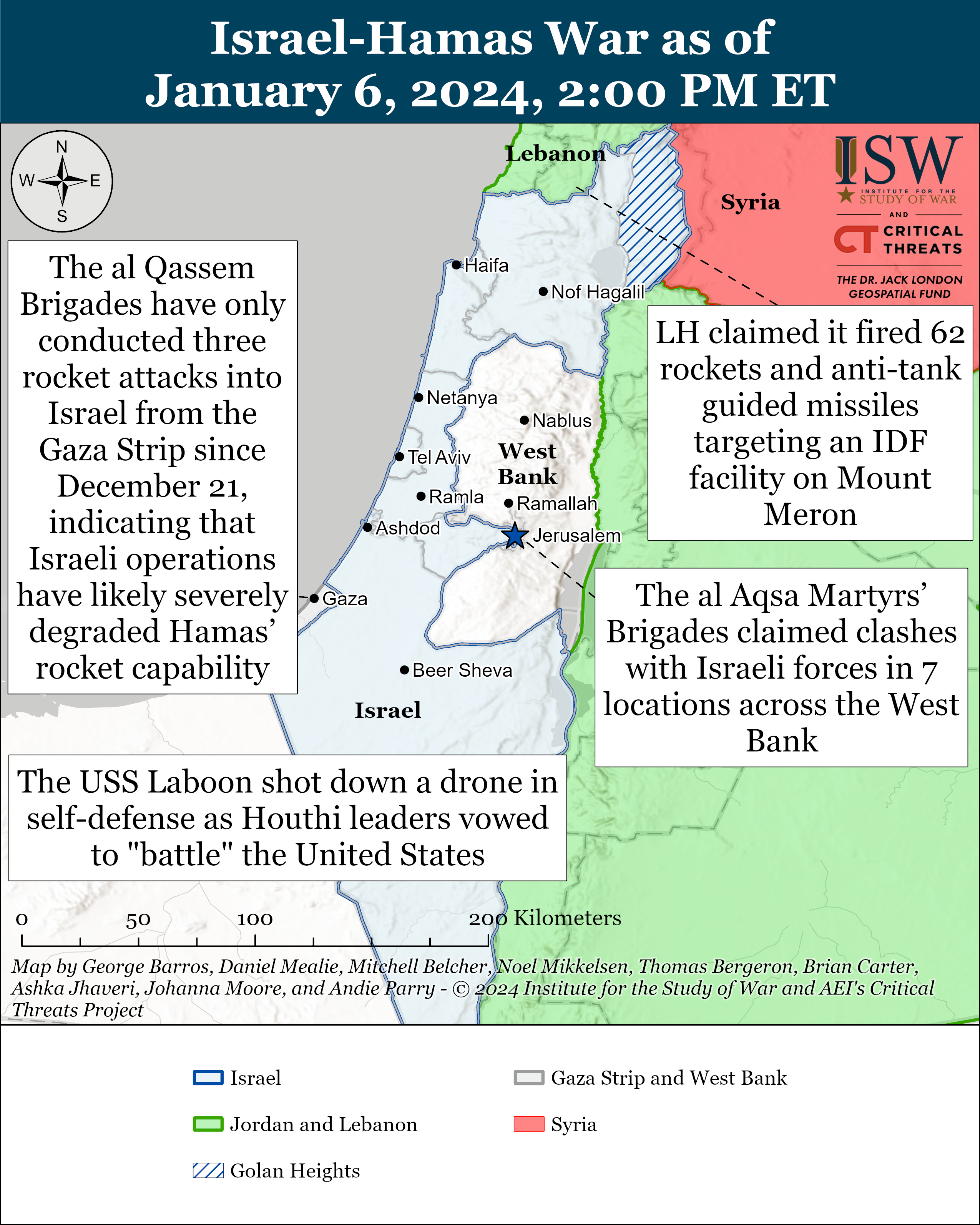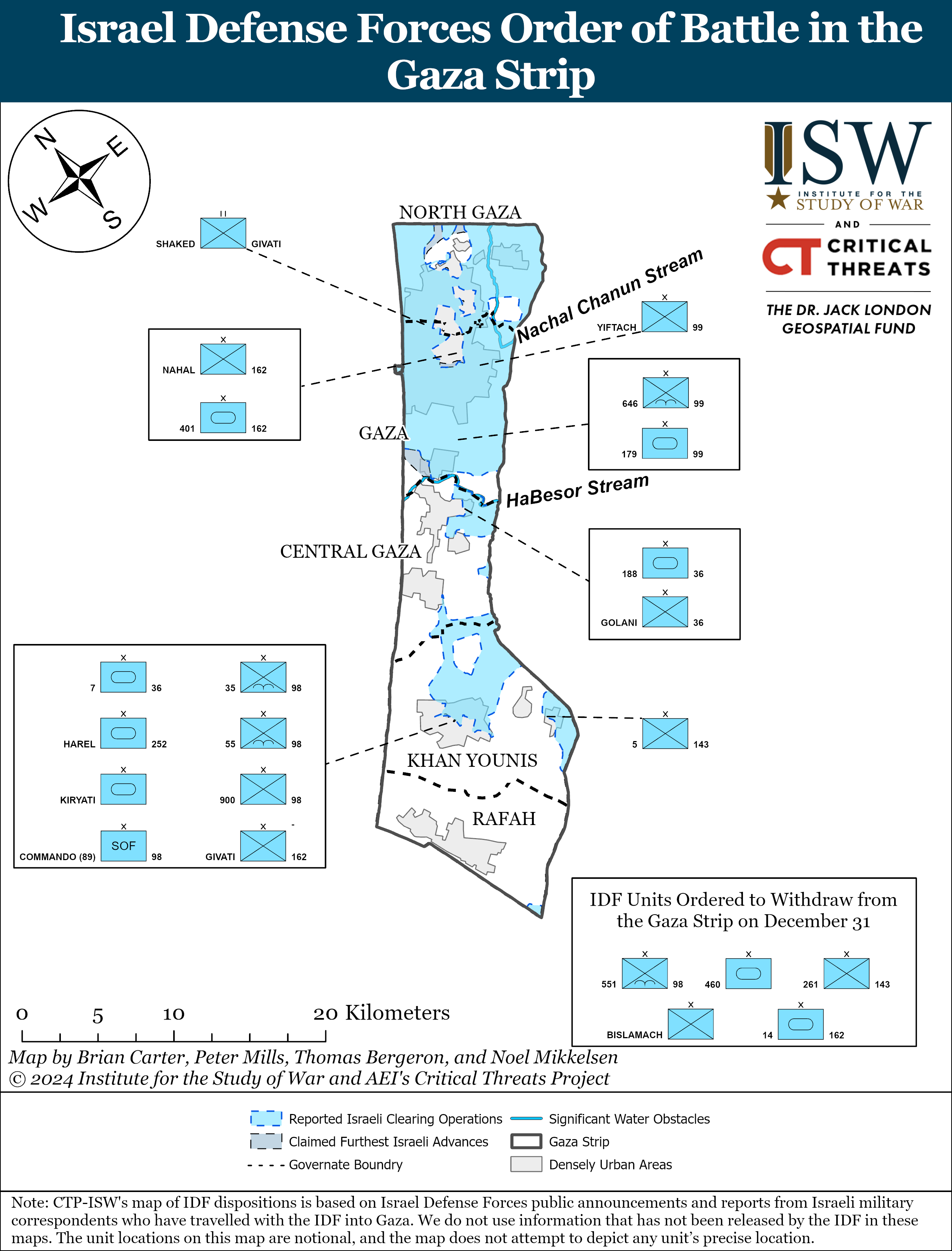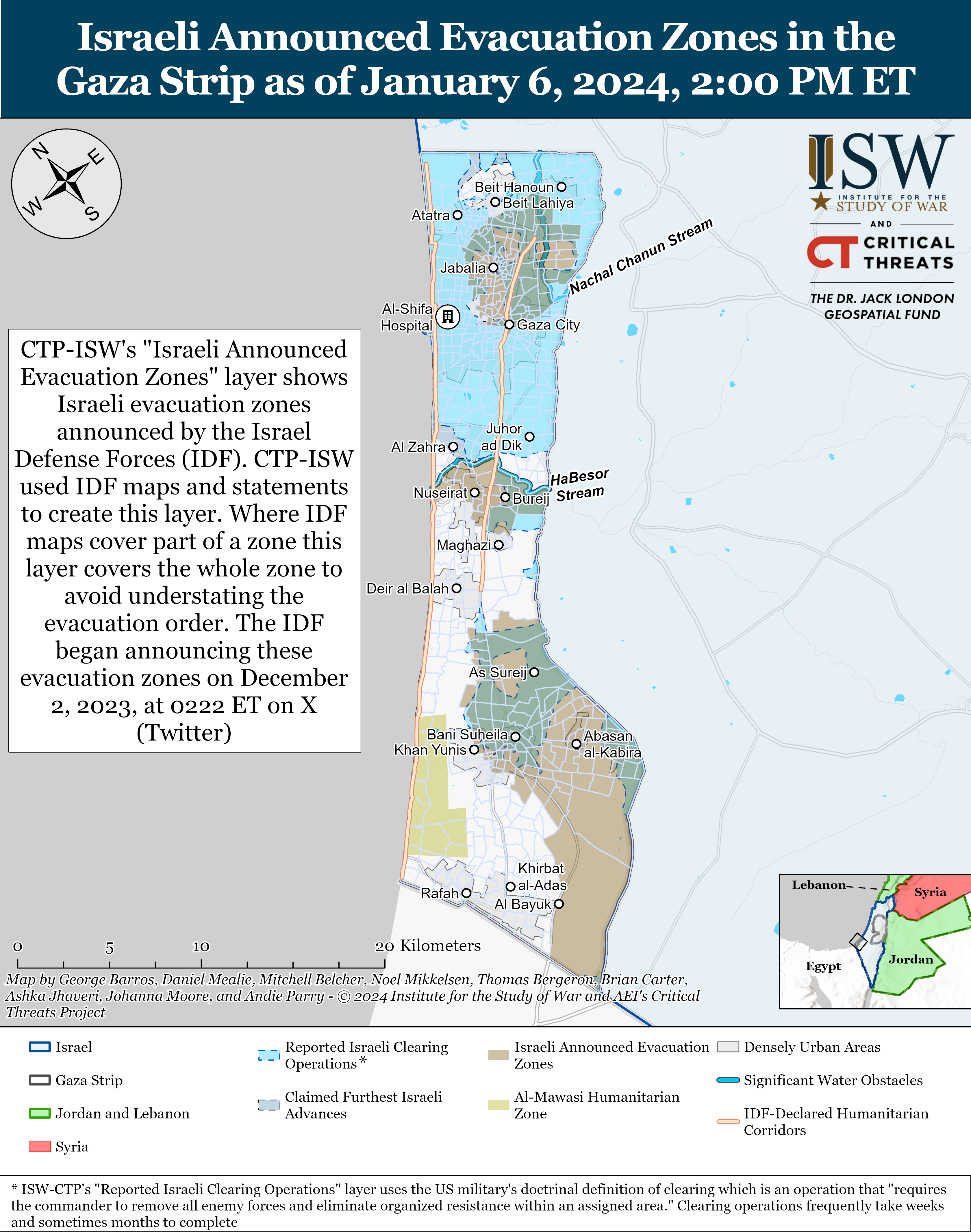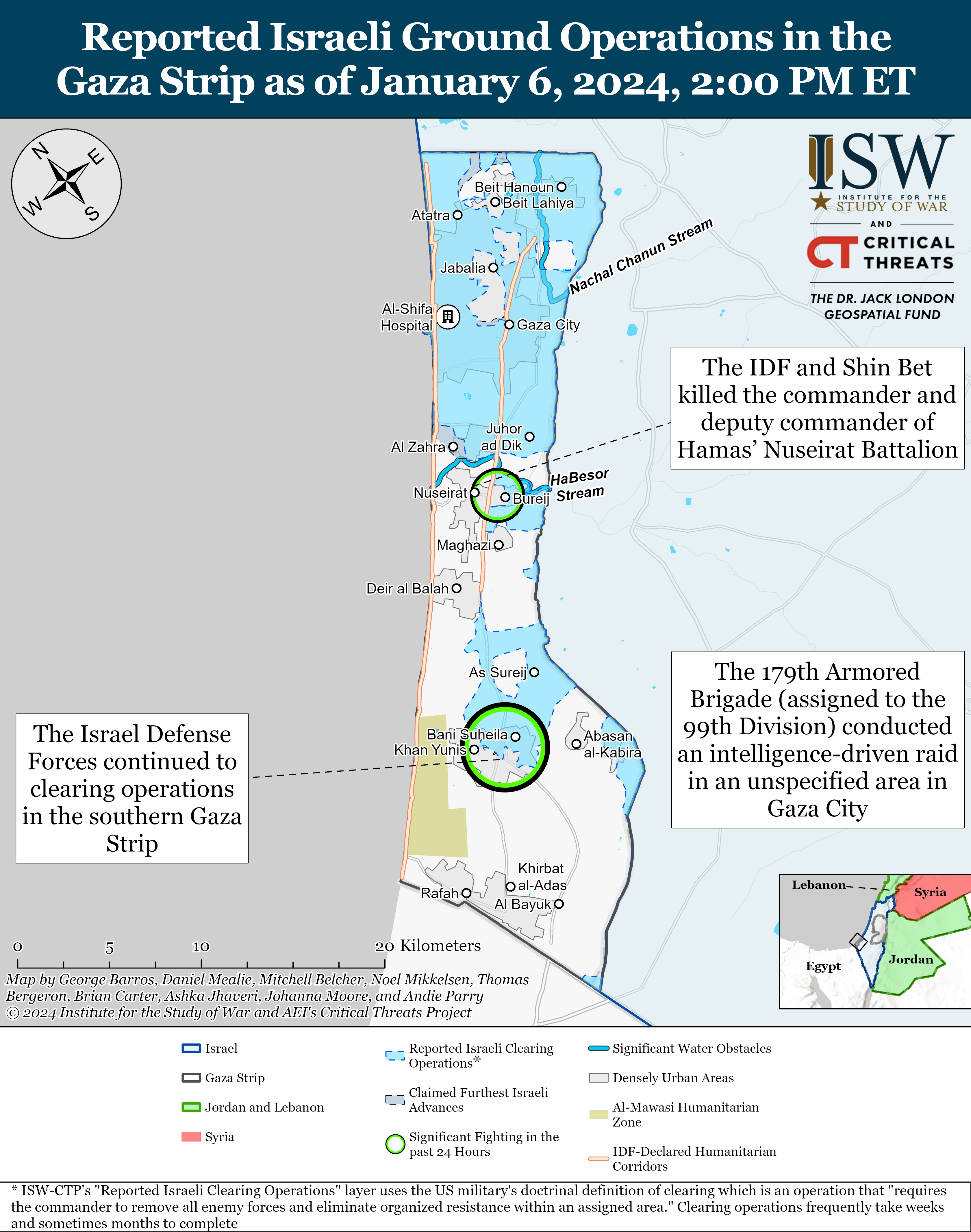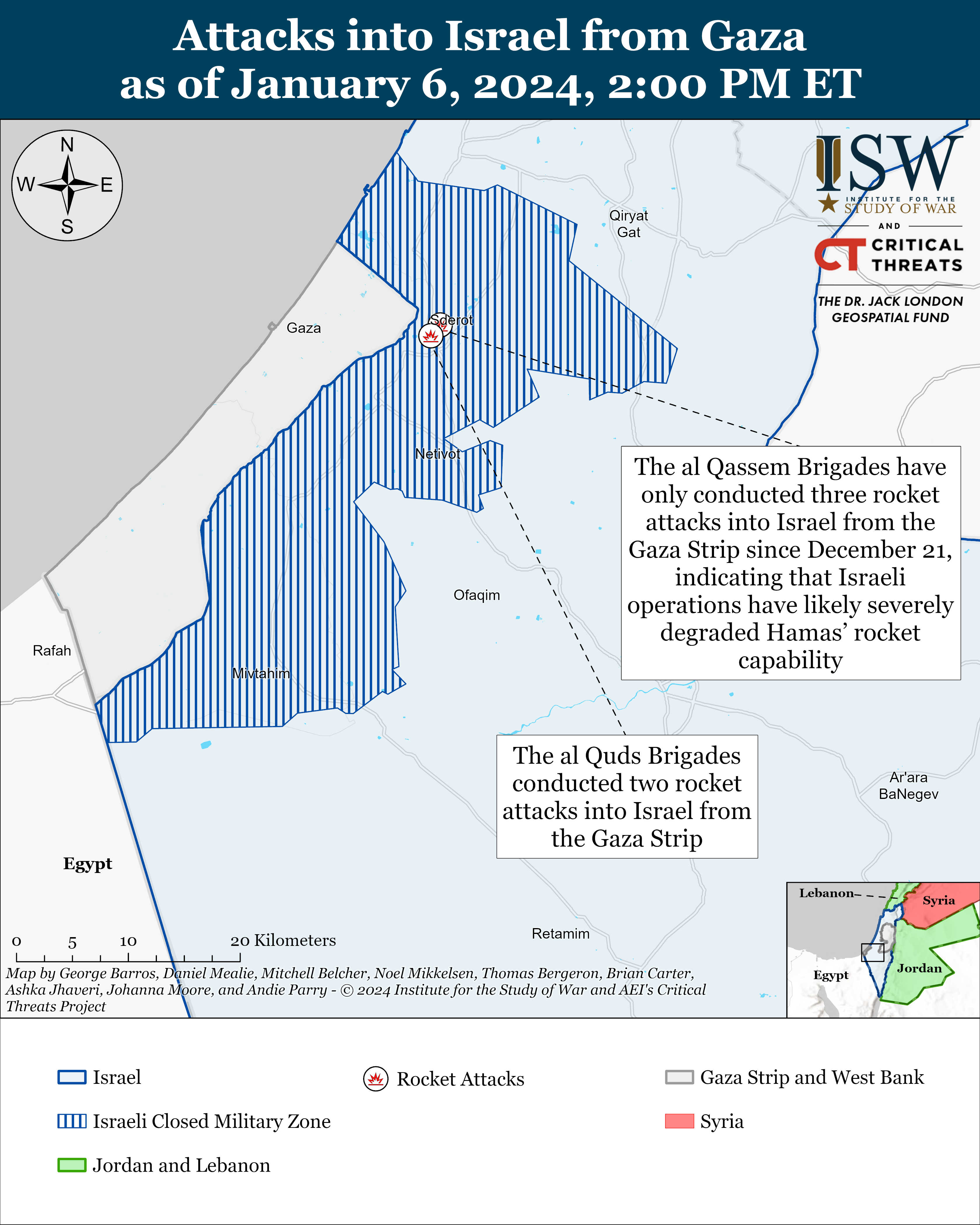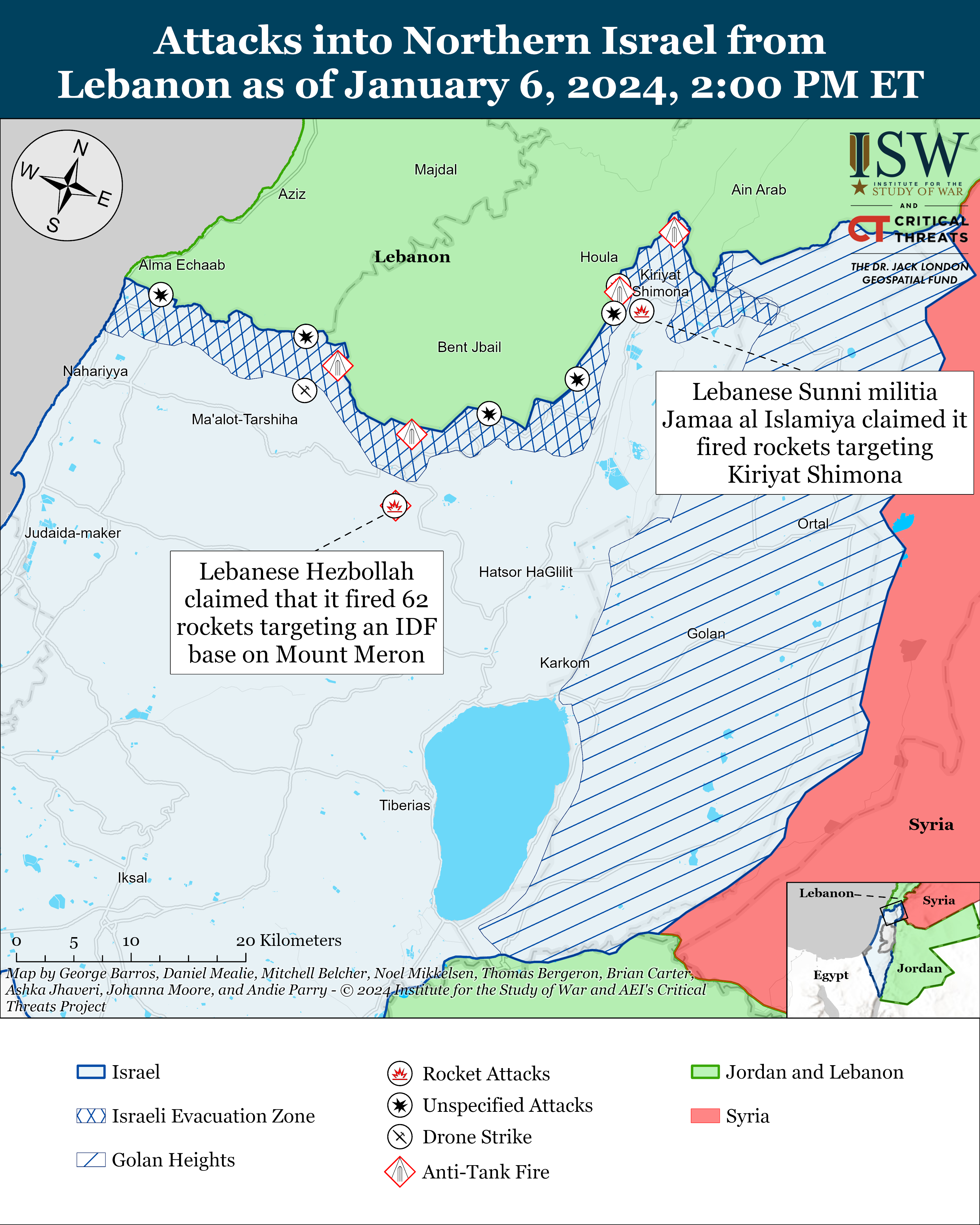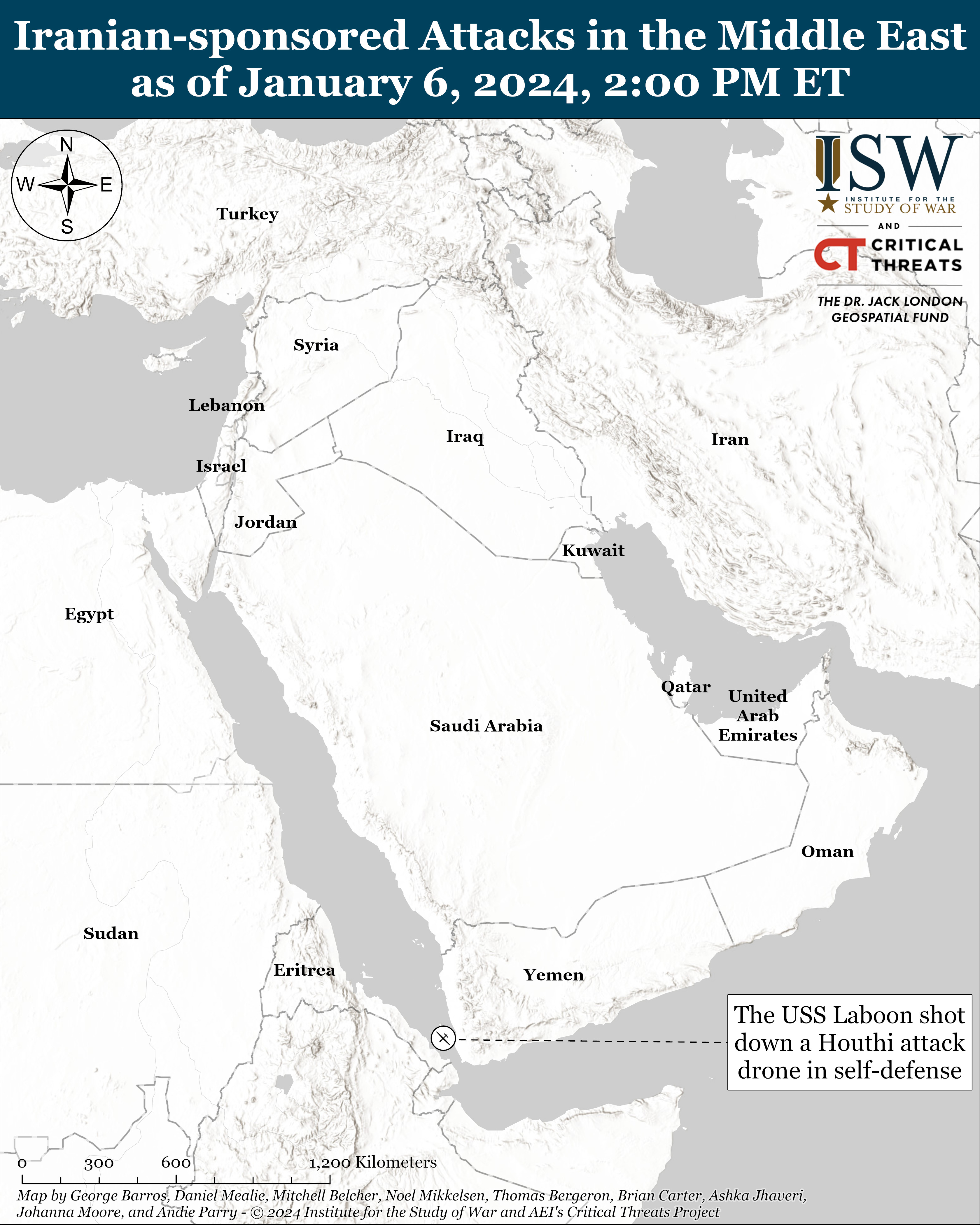Iran Update, January 6, 2024
Brian Carter, Peter Mills, Andie Parry, Alexandra Braverman, and Nicholas Carl
Information Cutoff: 2:00 pm EST
The Iran Update provides insights into Iranian and Iranian-sponsored activities abroad that undermine regional stability and threaten US forces and interests. It also covers events and trends that affect the stability and decision-making of the Iranian regime. The Critical Threats Project (CTP) at the American Enterprise Institute and the Institute for the Study of War (ISW) provides these updates regularly based on regional events. For more on developments in Iran and the region, see our interactive map of Iran and the Middle East.
Note: CTP and ISW have refocused the update to cover the Israel-Hamas war. The new sections address developments in the Gaza Strip, the West Bank, Lebanon, and Syria, as well as noteworthy activity from Iran’s Axis of Resistance. We do not report in detail on war crimes because these activities are well-covered in Western media and do not directly affect the military operations we are assessing and forecasting. We utterly condemn violations of the laws of armed conflict and the Geneva Conventions and crimes against humanity even though we do not describe them in these reports.
Click here to see CTP and ISW’s interactive map of Israeli ground operations. This map is updated daily alongside the static maps present in this report.
Key Takeaways:
- Hamas’ military wing, the al Qassem Brigades, is reporting some attacks in the central and southern Gaza Strip only after its fighters return to rear areas. The delays in reporting to higher headquarters may indicate a loss of command-and-control over some al Qassem Brigades units engaged with Israeli forces.
- The al Qassem Brigades have only conducted three rocket attacks into Israel from the Gaza Strip since December 21, indicating that Israeli operations have severely degraded Hamas’ rocket capability.
- The Hamas-run Gazan Health Ministry reported on January 6 that some operating rooms at al Shifa Hospital resumed operations.
- The al Aqsa Martyrs’ Brigades claimed that it clashed with Israeli forces in 7 locations across the West Bank.
- Lebanese Hezbollah claimed that it fired 62 rockets and anti-tank guided missiles targeting an IDF facility on Mount Meron.
- The Islamic Resistance in Iraq—a coalition of Iranian-backed Iraqi militias—claimed responsibility for drone attacks targeting two US positions in Syria on January 5.
- The Houthis continued attacking and harassing US naval forces and commercial shipping in the Red Sea on January 6. Houthi military leaders signaled on January 6 that they intend to retaliate for the US self-defense fire that killed ten Houthi fighters on December 30.
- Iranian officials continued emphasizing the false narrative that the United States created ISIS to blame the United States and Israel for the January 3 terrorist attack in Kerman City, Iran.
Gaza Strip
Axis of Resistance campaign objectives:
- Erode the will of the Israeli political establishment and public to launch and sustain a major ground operation into the Gaza Strip
- Degrade IDF material and morale around the Gaza Strip.
The Israel Defense Forces (IDF) continued conducting clearing operations in the northern Gaza Strip on January 6. The IDF said that the 179th Armored Brigade (assigned to the 99th Division) conducted an intelligence-driven raid in an unspecified area in Gaza City.[1] The brigade captured Hamas military equipment in UNRWA bags in a UNRWA clinic.[2] The brigade also captured RPGs, Kalashnikovs, and small arms ammunition in a nearby building.[3] The Nahal Brigade (assigned to the 162nd Division) engaged several Hamas fighters in Beit Lahia on January 5.[4] Artillery units from the 215th Artillery Brigade and the 143rd (Gaza) Division’s artillery units provided fire support to the Nahal Brigade in Beit Lahia.[5]
CTP-ISW’s map of IDF dispositions is based on Israel Defense Forces public announcements and reports from Israeli military correspondents who have traveled with the IDF into Gaza. We do not use information that has not been released by the IDF in these maps. The unit locations on this map are notional, and the map does not attempt to depict any unit’s precise location.
The IDF and Shin Bet killed the commander and deputy commander of Hamas’ Nuseirat Battalion on January 6. The IDF killed the previous Nuseirat Battalion deputy commander on October 24.[6] The IDF said that the battalion commander had previously served as a Nukhba company commander and a rocket forces operator.[7] Nukhba units are Hamas’ special operations forces. The IDF reported that the deputy battalion commander held many “field and headquarters positions,” including in the Hamas “training program.”[8] The IDF said that the Nuseirat Battalion previously launched drones at Israeli forces in the Gaza Strip.[9]
Hamas’ military wing, the al Qassem Brigades, is reporting some attacks in the central and southern Gaza Strip only after its fighters return to rear areas. The delays in reporting to higher headquarters may indicate a loss of command-and-control over some al Qassem Brigades units engaged with Israeli forces. The al Qassem Brigades claimed on January 6 that its fighters “returned from the [frontlines in Bureij]” and reported that they detonated one Shawaz explosively formed penetrator and fired one Yassin 105 rocket-propelled grenade (RPG) targeting Israeli armor.[10] The inability of these fighters to communicate with higher headquarters until returning to rear areas indicates that their commanders may be unable to transmit orders to fighters that are engaged with Israeli forces. The al Qassem Brigades also said that its fighters reported two attacks after they returned from the frontlines east of Khan Younis.[11]
The IDF continued conducting clearing operations in the southern Gaza Strip on January 6. The 35th Paratroopers Brigade (assigned to the 98th Division) captured a weapons cache, including Kalashnikovs, ammunition, RPGs, and remotely detonated explosive devices.[12] An Israeli military correspondent reported on December 31 that the 35th Paratroopers Brigade redeployed from the northern Gaza Strip to the southern Gaza Strip.[13] Israeli forces advanced west on the al Eim road outside the al Amal Hospital on January 6, according to geolocated footage.[14]
Palestinian militias continued to attempt to defend against Israeli advances in Khan Younis on January 5 and 6. The al Qassem Brigades ambushed an Israeli infantry squad in Bani Suheila on January 5. The brigades claimed that they killed and injured multiple Israeli soldiers.[15] The Palestinian Islamic Jihad’s (PIJ) military wing, the al Quds Brigades, fired small arms and RPGs at Israeli forces near Maan, Khan Younis, and in central Khan Younis on January 6.[16] The Democratic Front for the Liberation of Palestine’s military wing, the National Resistance Brigades, detonated an improvised explosive device (IED) targeting Israeli armor near Mahatta, Khan Younis.[17]
The IDF Egoz Unit (assigned to the 89th Commando Brigade) conducted several raids in Khan Younis on January 6.[18] The Egoz Unit raided the home of Hamas’ Eastern (Khan Younis) Battalion commander. The IDF did not elaborate on the results of the raid. The Egoz Unit also raided a school in Bani Suheila. The IDF said that the unit killed three Hamas fighters and captured RPGs and intelligence.
The al Qassem Brigades detonated an anti-personnel IED targeting Israeli infantry near Khuzaa on January 6.[19]
The Hamas-run Gazan Health Ministry reported on January 6 that some operating rooms at al Shifa Hospital resumed operations.[20]
The al Qassem Brigades have only conducted three rocket attacks into Israel from the Gaza Strip since December 21, indicating that Israeli operations have severely degraded Hamas’ rocket capability. The al Qassem Brigades claimed two rocket attacks targeting Holit and Tel Aviv on December 21 and one attack targeting Tel Aviv on January 1.[21]
The al Quds Brigades conducted two rocket attacks into Israel from the Gaza Strip on January 6.[22]
Recorded reports of rocket attacks; CTP-ISW cannot independently verify impact.
West Bank
Axis of Resistance campaign objectives:
- Draw IDF assets and resources toward the West Bank and fix them there
The al Aqsa Martyrs’ Brigades claimed that it clashed with Israeli forces in 7 locations across the West Bank. The al Aqsa Martyrs’ Brigades claimed that it conducted a combined ambush with the al Quds Brigades targeting two IDF soldiers in Tulkarm.[23] The al Aqsa Martyrs’ Brigades targeted Israeli forces with small arms fire and IEDs during Israeli raids in Balata, Nablus, for the second consecutive day.[24] The al Aqsa Martyrs’ Brigades detonated IEDs and fired small arms targeting Israeli forces during Israeli raids in Qalqilya as well.[25] The al Aqsa Martyrs’ Brigades fired small arms targeting Israeli checkpoints in Gerizim and Jalama.[26]
This map is not an exhaustive depiction of clashes and demonstrations in the West Bank.
Southern Lebanon and Golan Heights
Axis of Resistance campaign objectives:
- Draw IDF assets and resources toward northern Israel and fix them there
- Set conditions for successive campaigns into northern Israel
Iranian-backed militias, including Lebanese Hezbollah (LH), conducted 14 attacks from southern Lebanon into northern Israel on January 6. LH claimed that it fired 62 rockets and anti-tank guided missiles targeting an IDF facility on Mount Meron.[27] LH said that the base hosts IDF air traffic control, radar, surveillance, communication, and jamming facilities.[28] LH framed the attack as an “initial response” to Israel’s killing of Hamas Political Bureau Deputy Chairman Saleh al Arouri in Beirut on January 2.[29] The IDF stated that it conducted retaliatory airstrikes targeting a group of fighters who partook in the attack on Mount Meron.[30] LH claimed six other attacks targeting IDF soldiers and Israeli military positions along the Israel-Lebanon border.[31] Unspecified fighters separately launched three anti-tank guided missiles at towns in northern Israel.[32] Lebanese Sunni militia Jamaa al Islamiya claimed that it fired rockets targeting Kiryat Shmona.[33]
Recorded reports of attacks; CTP-ISW cannot independently verify impact.
Iran and Axis of Resistance
Axis of Resistance campaign objectives:
- Demonstrate the capability and willingness of Iran and the Axis of Resistance to escalate against the United States and Israel on multiple fronts
- Set conditions to fight a regional war on multiple fronts
The Islamic Resistance in Iraq—a coalition of Iranian-backed Iraqi militias—claimed responsibility for drone attacks targeting two US positions in Syria on January 5.[34] The group launched one-way attack drones at the al Tanf garrison and al Shadaddi base.
The Houthis continued attacking and harassing US naval forces and commercial shipping in the Red Sea on January 6. CENTCOM said that the USS Laboon, acting in self-defense, shot down a drone launched from Houthi-controlled Yemen in the southern Red Sea.[35] The UK Maritime Trade Operations organization separately reported that US-led coalition forces thwarted a suspected hijacking attempt by six small boats off the coast of Yemen.[36] Both attempted attacks follow a statement from the United States and 12 of its international partners on January 3 warning that the Houthis will face unspecified consequences if the group continues to attack shipping in the Red Sea.[37]
Houthi military leaders signaled on January 6 that they intend to retaliate for the US self-defense fire that killed ten Houthi fighters on December 30. Houthi fighters fired on a US Navy helicopter on December 30, causing the helicopter to respond in self-defense. Houthi military and political leaders held a meeting to discuss implementing “directives” from Houthi Supreme Leader Abdulmalik al Houthi. These “directives” are likely a reference to Abdulmalik’s January 4 statement vowing to respond to a US self-defense strike on Houthi naval forces.[38] The Houthi president vowed a “strong response” to the US self-defense strike that he claimed, “launched a new battle with the American enemy.”[39]
Iranian officials continued emphasizing the false narrative that the United States created ISIS to blame the United States and Israel for the January 3 terrorist attack in Kerman City, Iran.[40] Interior Minister Ahmad Vahidi claimed that the United States created ISIS and added that ISIS is now an agent of Israel. Vahidi claimed that the actions of ISIS illustrate Israel’s fear of the other countries in the region. Vahidi stated the Ebrahim Raisi administration is working to respond to the enemies of Iran who were responsible for the attack. The Afghan branch of the Islamic State, known as Islamic State Khorasan Province (ISKP), claimed responsibility for the Kerman attack on January 5.[41]
Iranian President Ebrahim Raisi discussed the Israel-Hamas war and the ISKP attack in Kerman at an event in Zanjan Province on January 6.[42] Raisi said that Iran will continue to support the Palestinian people and all oppressed people around the world.[43] Raisi also condemned the ISKP attack.
The IRGC Navy commissioned the Shahid Abu Mahdi al Muhandis naval vessel into its fleet on January 6.[44] IRGC commander Major General Hossein Salami and IRGC Navy Commander Rear Admiral Alireza Tangsiri attended the commissioning ceremony in Bandar Abbas. The IRGC Navy said that the vessel has “radar-evading” technologies and can host vertical take-off and landing drones.[45] The commissioning of this vessel is part of the long-standing IRGC effort to strengthen its military capabilities and influence in and around the Persian Gulf.[46]
[43] https://www.presstv dot ir/Detail/2024/01/06/717712/Israel-will-eventually-collapse-despite-arrogant-powers%E2%80%99-support,-says-President-Raeisi
[45] https://www.presstv dot ir/Detail/2024/01/06/717697/IRGC-Navy-takes-delivery-of-homegrown-Abu-Mahdi-Muhandis-warship,-fast-attack-craft


